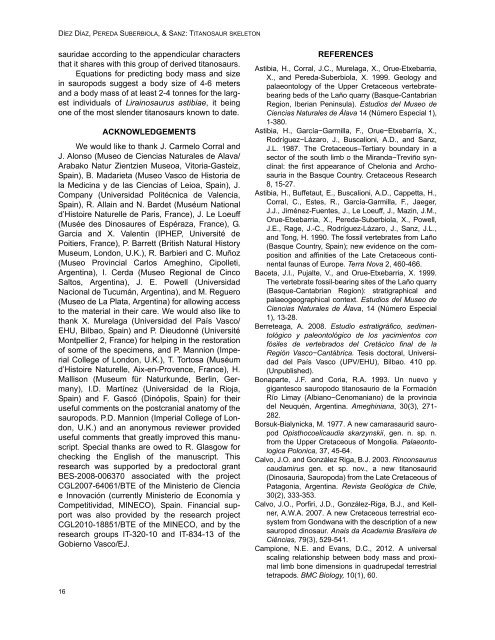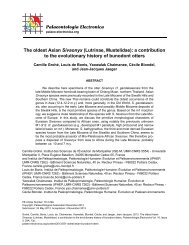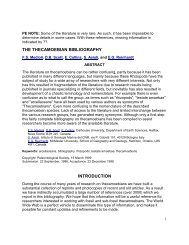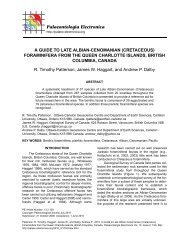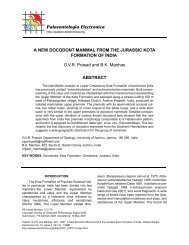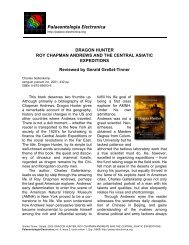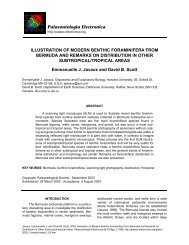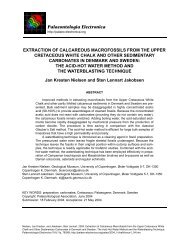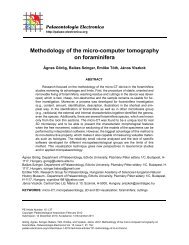Appendicular skeleton and dermal armour of the Late Cretaceous ...
Appendicular skeleton and dermal armour of the Late Cretaceous ...
Appendicular skeleton and dermal armour of the Late Cretaceous ...
You also want an ePaper? Increase the reach of your titles
YUMPU automatically turns print PDFs into web optimized ePapers that Google loves.
DÍEZ DÍAZ, PEREDA SUBERBIOLA, & SANZ: TITANOSAUR SKELETON<br />
sauridae according to <strong>the</strong> appendicular characters<br />
that it shares with this group <strong>of</strong> derived titanosaurs.<br />
Equations for predicting body mass <strong>and</strong> size<br />
in sauropods suggest a body size <strong>of</strong> 4-6 meters<br />
<strong>and</strong> a body mass <strong>of</strong> at least 2-4 tonnes for <strong>the</strong> largest<br />
individuals <strong>of</strong> Lirainosaurus astibiae, it being<br />
one <strong>of</strong> <strong>the</strong> most slender titanosaurs known to date.<br />
ACKNOWLEDGEMENTS<br />
We would like to thank J. Carmelo Corral <strong>and</strong><br />
J. Alonso (Museo de Ciencias Naturales de Alava/<br />
Arabako Natur Zientzien Museoa, Vitoria-Gasteiz,<br />
Spain), B. Madarieta (Museo Vasco de Historia de<br />
la Medicina y de las Ciencias <strong>of</strong> Leioa, Spain), J.<br />
Company (Universidad Politécnica de Valencia,<br />
Spain), R. Allain <strong>and</strong> N. Bardet (Muséum National<br />
d’Histoire Naturelle de Paris, France), J. Le Loeuff<br />
(Musée des Dinosaures <strong>of</strong> Espéraza, France), G.<br />
Garcia <strong>and</strong> X. Valentin (IPHEP, Université de<br />
Poitiers, France), P. Barrett (British Natural History<br />
Museum, London, U.K.), R. Barbieri <strong>and</strong> C. Muñoz<br />
(Museo Provincial Carlos Ameghino, Cipolleti,<br />
Argentina), I. Cerda (Museo Regional de Cinco<br />
Saltos, Argentina), J. E. Powell (Universidad<br />
Nacional de Tucumán, Argentina), <strong>and</strong> M. Reguero<br />
(Museo de La Plata, Argentina) for allowing access<br />
to <strong>the</strong> material in <strong>the</strong>ir care. We would also like to<br />
thank X. Murelaga (Universidad del País Vasco/<br />
EHU, Bilbao, Spain) <strong>and</strong> P. Dieudonné (Université<br />
Montpellier 2, France) for helping in <strong>the</strong> restoration<br />
<strong>of</strong> some <strong>of</strong> <strong>the</strong> specimens, <strong>and</strong> P. Mannion (Imperial<br />
College <strong>of</strong> London, U.K.), T. Tortosa (Muséum<br />
d’Histoire Naturelle, Aix-en-Provence, France), H.<br />
Mallison (Museum für Naturkunde, Berlin, Germany),<br />
I.D. Martínez (Universidad de la Rioja,<br />
Spain) <strong>and</strong> F. Gascó (Dinópolis, Spain) for <strong>the</strong>ir<br />
useful comments on <strong>the</strong> postcranial anatomy <strong>of</strong> <strong>the</strong><br />
sauropods. P.D. Mannion (Imperial College <strong>of</strong> London,<br />
U.K.) <strong>and</strong> an anonymous reviewer provided<br />
useful comments that greatly improved this manuscript.<br />
Special thanks are owed to R. Glasgow for<br />
checking <strong>the</strong> English <strong>of</strong> <strong>the</strong> manuscript. This<br />
research was supported by a predoctoral grant<br />
BES-2008-006370 associated with <strong>the</strong> project<br />
CGL2007-64061/BTE <strong>of</strong> <strong>the</strong> Ministerio de Ciencia<br />
e Innovación (currently Ministerio de Economía y<br />
Competitividad, MINECO), Spain. Financial support<br />
was also provided by <strong>the</strong> research project<br />
CGL2010-18851/BTE <strong>of</strong> <strong>the</strong> MINECO, <strong>and</strong> by <strong>the</strong><br />
research groups IT-320-10 <strong>and</strong> IT-834-13 <strong>of</strong> <strong>the</strong><br />
Gobierno Vasco/EJ.<br />
REFERENCES<br />
Astibia, H., Corral, J.C., Murelaga, X., Orue-Etxebarria,<br />
X., <strong>and</strong> Pereda-Suberbiola, X. 1999. Geology <strong>and</strong><br />
palaeontology <strong>of</strong> <strong>the</strong> Upper <strong>Cretaceous</strong> vertebratebearing<br />
beds <strong>of</strong> <strong>the</strong> Laño quarry (Basque-Cantabrian<br />
Region, Iberian Peninsula). Estudios del Museo de<br />
Ciencias Naturales de Álava 14 (Número Especial 1),<br />
1-380.<br />
Astibia, H., García−Garmilla, F., Orue−Etxebarría, X.,<br />
Rodríguez−Lázaro, J., Buscalioni, A.D., <strong>and</strong> Sanz,<br />
J.L. 1987. The <strong>Cretaceous</strong>–Tertiary boundary in a<br />
sector <strong>of</strong> <strong>the</strong> south limb o <strong>the</strong> Mir<strong>and</strong>a−Treviño synclinal:<br />
<strong>the</strong> first appearance <strong>of</strong> Chelonia <strong>and</strong> Archosauria<br />
in <strong>the</strong> Basque Country. <strong>Cretaceous</strong> Research<br />
8, 15-27.<br />
Astibia, H., Buffetaut, E., Buscalioni, A.D., Cappetta, H.,<br />
Corral, C., Estes, R., García-Garmilla, F., Jaeger,<br />
J.J., Jiménez-Fuentes, J., Le Loeuff, J., Mazin, J.M.,<br />
Orue-Etxebarria, X., Pereda-Suberbiola, X., Powell,<br />
J.E., Rage, J.-C., Rodríguez-Lázaro, J., Sanz, J.L.,<br />
<strong>and</strong> Tong, H. 1990. The fossil vertebrates from Laño<br />
(Basque Country, Spain); new evidence on <strong>the</strong> composition<br />
<strong>and</strong> affinities <strong>of</strong> <strong>the</strong> <strong>Late</strong> <strong>Cretaceous</strong> continental<br />
faunas <strong>of</strong> Europe. Terra Nova 2, 460-466.<br />
Baceta, J.I., Pujalte, V., <strong>and</strong> Orue-Etxebarria, X. 1999.<br />
The vertebrate fossil-bearing sites <strong>of</strong> <strong>the</strong> Laño quarry<br />
(Basque-Cantabrian Region): stratigraphical <strong>and</strong><br />
palaeogeographical context. Estudios del Museo de<br />
Ciencias Naturales de Álava, 14 (Número Especial<br />
1), 13-28.<br />
Berreteaga, A. 2008. Estudio estratigráfico, sedimentológico<br />
y paleontológico de los yacimientos con<br />
fósiles de vertebrados del Cretácico final de la<br />
Región Vasco−Cantábrica. Tesis doctoral, Universidad<br />
del País Vasco (UPV/EHU), Bilbao. 410 pp.<br />
(Unpublished).<br />
Bonaparte, J.F. <strong>and</strong> Coria, R.A. 1993. Un nuevo y<br />
gigantesco sauropodo titanosaurio de la Formación<br />
Río Limay (Albiano−Cenomaniano) de la provincia<br />
del Neuquén, Argentina. Ameghiniana, 30(3), 271-<br />
282.<br />
Borsuk-Bialynicka, M. 1977. A new camarasaurid sauropod<br />
Opisthocoelicaudia skarzynskii, gen. n. sp. n.<br />
from <strong>the</strong> Upper <strong>Cretaceous</strong> <strong>of</strong> Mongolia. Palaeontologica<br />
Polonica, 37, 45-64.<br />
Calvo, J.O. <strong>and</strong> González Riga, B.J. 2003. Rinconsaurus<br />
caudamirus gen. et sp. nov., a new titanosaurid<br />
(Dinosauria, Sauropoda) from <strong>the</strong> <strong>Late</strong> <strong>Cretaceous</strong> <strong>of</strong><br />
Patagonia, Argentina. Revista Geológica de Chile,<br />
30(2), 333-353.<br />
Calvo, J.O., Porfiri, J.D., González-Riga, B.J., <strong>and</strong> Kellner,<br />
A.W.A. 2007. A new <strong>Cretaceous</strong> terrestrial ecosystem<br />
from Gondwana with <strong>the</strong> description <strong>of</strong> a new<br />
sauropod dinosaur. Anais da Academia Brasileira de<br />
Ciências, 79(3), 529-541.<br />
Campione, N.E. <strong>and</strong> Evans, D.C., 2012. A universal<br />
scaling relationship between body mass <strong>and</strong> proximal<br />
limb bone dimensions in quadrupedal terrestrial<br />
tetrapods. BMC Biology, 10(1), 60.<br />
16


